Museo Regional Molino Andes (SPA-ENG)
Alguna vez leí una frase que dejó una marca indeleble en mi espíritu: "nadie ama lo que desconoce". Maravilloso resumen de lo que significa historia.
Por alguna razón no del todo comprendida, siempre me atrajo la historia, no tanto esa que narra los acontecimientos relevantes de nuestros héroes de la patria, los viajes colonizadores o las andanzas europeas, tampoco las antiguas Grecia y Roma, aunque en algún tiempo también eso me fascinaba.
Me apasionan las memorias locales, las que permiten conocer a las personas, las historias mínimas. Me gusta diseccionar el pasado en pequeños relatos, narraciones de situaciones particulares, leyendas, allí, uniendo pedazos, es donde encuentro mayor sentido a lo que forja una nación como tal.
Trevelin es un pequeño pueblo de la Patagonia Andina, alguna vez fue solamente un asentamiento que luego se convirtió en aldea para llegar al presente aun a salvo de las condiciones que imponen las grandes urbes.
El bucólico pueblo nació gracias a la inmigración galesa que algunos años antes había arribado a nuestro país formando sus primeros asentamientos en la costa del mar argentino, el espíritu aventurero y la necesidad de tierras más aptas para el cultivo, hizo posible que los colonos poco tardaran en conocer que sobre la Cordillera de los Andes había zonas mucho más fértiles y paisajes maravillosos. Acompañados y guiados por indígenas locales realizaron diversas exploraciones para dar finalmente con el paraíso al que denominaron valle 16 de octubre, donde se asentaron y formaron el pueblo del que estamos tratando.
En ese lugar formaron raíces y se integraron con los pueblos originarios en una simbiosis impensada, aunque lógica, elemental. Allí formaron sus hogares y sus historias, gran parte de la cual se puede apreciar y de la mejor manera, en el Museo Regional Molino Andes.
El imponente edificio del museo se encuentra a pocas cuadras del casco central del pueblo cuyo epicentro es la plaza Coronel Fontana y tiene, como todo, su propia historia.
La construcción que ahora alberga la muestra acaba de cumplir 107 años pocos días atrás, según reza la información disponible, fue construido y fundado por John Daniel Evans, uno de los inmigrantes galeses de mayor preponderancia en su comunidad por aquellos años.
El establecimiento surgió como respuesta a la necesidad de contar con un espacio funcional para la molienda del trigo que por ese entonces era la principal fuente de trabajo, ingresos y alimento de toda la región en general y de Trevelin y sus alrededores en particular.
El escudo de Chubut, provincia en la que se encuentra emplazado el valle 16 de octubre, es el único entre los 24 escudos provinciales de la Argentina que tiene una espiga de trigo dibujada en su centro, paradójicamente, hoy en día esta provincia no se encuentra entre las principales productoras del preciado cereal en el país, ¿la causa? políticas y políticos, pero esa es otra historia.
Desde su construcción, no solamente fue el lugar donde se almacenaba y molía el trigo sino también, por su tamaño y funcionalidad, un centro de reuniones donde se tomaban decisiones importantes respecto al funcionamiento y la administración de toda la comunidad.
Con el paso del tiempo, la presión ejercida desde la zona central de país hizo que Chubut abandonara la siembra y cosecha del trigo, el molino perdió su razón de ser.
Todas las maquinarias fueron vendidas allá por el año 1958 y el edificio sufrió el abandono. Para peor, en 1972 un incendio de grandes proporciones lo dejó totalmente en ruinas, sin embargo, el espíritu de la comunidad lo rescató para convertirlo en 1985 en el lugar de alojamiento definitivo del actual museo que funcionaba desde unos años antes en otra construcción más pequeña e incómoda.
El recorrido por los cuatro pisos que conforman la muestra es soberbio, espacios reservados para los pueblos originarios, su forma de vida, su arte, su vestimenta. También hay lugar para observar en detalle la inmigración galesa, sus pioneros, su gente, sus herramientas antiguas y la adaptación a los avances tecnológicos. Por supuesto hay un espacio donde se puede apreciar la mezcla de ambas culturas, la formación de nuevas familias y descendientes entre originarios y migrantes.
Las horas transcurren y nunca se termina de ver, de leer, de sorprendernos con alguna característica o un objeto de tiempos pasados. Todos los textos y explicaciones se encuentran en español, inglés y galés.
Una muestra alucinante, perfectamente ordenada y con documentación de primera calidad, una visión testimonial de cómo se formó y evolucionó esa comunidad pujante y emprendedora, pero sin embargo tradicionalista, una historia mínima dentro del concierto complejo y entramado de una nación.
Una historia para conocer, aprender y disfrutar.
Andes Mill Regional Museum
I once read something that left an indelible mark on my spirit: "No one loves what they don't know." This is an excellent summary of what history means.
For some reason I don't fully understand, I've always been drawn to history, not so much the kind that narrates the relevant events of our homeland's heroes, the colonial voyages, or the adventures of Europe, nor the ancient Greeks and Romans. However, at one time, that fascinated me as well.
I'm passionate about local memories, those that allow us to get to know people, the minimal histories. I like to dissect the past into small stories, narratives of particular situations, and legends. It's there, by piecing together the pieces, that I find the greatest meaning in what forges a nation as such.
Trevelin is a small town in Andean Patagonia. Once merely a settlement, it later became a village, reaching the present, still safe from the conditions imposed by large cities.
The bucolic town was born thanks to the Welsh immigration that had arrived in our country a few years earlier, forming their first settlements on the Argentine coast. Their adventurous spirit and the need for more suitable land for cultivation made it possible for the settlers to quickly discover that the Andes Mountains contained much more fertile areas and wonderful landscapes. Accompanied and guided by local indigenous people, they carried out various explorations until they finally found the paradise they called the 16th of October Valley, where they settled and formed the town we are discussing.
In that place, they took root and integrated with the native peoples in an unexpected, yet logical, elemental symbiosis. There, they formed their homes and stories, much of which can be best appreciated at the Museo Regional Molino Andes.
The imposing museum building is located a few blocks from the town center, whose epicenter is Plaza Coronel Fontana, like everything else, has its history.
The building that now houses the exhibition turned 107 years old a few days ago. According to available information, it was built and founded by John Daniel Evans, one of the most prominent Welsh immigrants in his community.
The establishment arose in response to the need for a functional space for milling wheat, which at the time was the primary source of employment, income, and food for the entire region in general, and Trevelin and its surrounding areas in particular.
The coat of arms of Chubut, the province in which the 16 de Octubre Valley is located, is the only one of Argentina's 24 provincial coats of arms with an ear of wheat drawn in its center. Paradoxically, today, this province is not among the leading producers of this precious grain in the country. The reason? Politics and politicians, but that's another story.
Since its construction, it has not only been where wheat was stored and milled, but also, due to its size and functionality, a meeting center where vital decisions were made regarding the functioning and administration of the entire community.
Over time, pressure from the country's central region caused Chubut to abandon wheat planting and harvesting, the mill lost its purpose.
All the machinery was sold around 1958, and the building fell into disrepair. To make matters worse, a massive fire in 1972 left it entirely in ruins. However, the spirit of the community rescued it, converting it in 1985 into the permanent home of the current museum, which had been operating for a few years in a smaller and more uncomfortable building.
A tour of the four floors that make up the exhibition is superb, with spaces reserved for the indigenous peoples, their way of life, art, and clothing. There's also a space to observe Welsh immigration in detail, its pioneers, its people, its ancient tools, and its adaptation to technological advances. Of course, there's a space where you can appreciate the blending of both cultures, the formation of new families, and the descendants of natives and migrants.
The hours pass, and you never stop seeing, reading, or being surprised by some characteristic or object from times gone by. All the texts and explanations are in Spanish, English, and Welsh.
A stunning exhibition, perfectly organized and with top-quality documentation, a testimonial view of how this thriving and enterprising, yet traditionalist, community was formed and evolved, a brief history within a nation's complex and interwoven structure.
A history to discover, learn, and enjoy.
Héctor Gugliermo
@hosgug

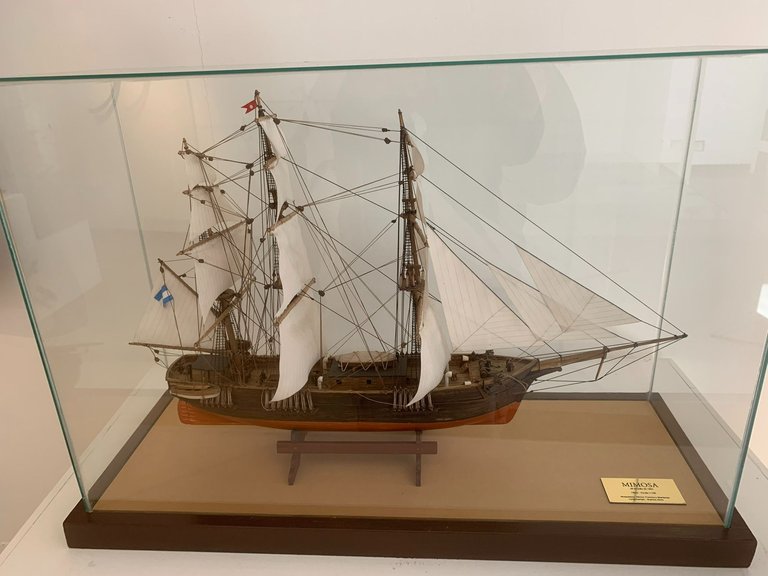
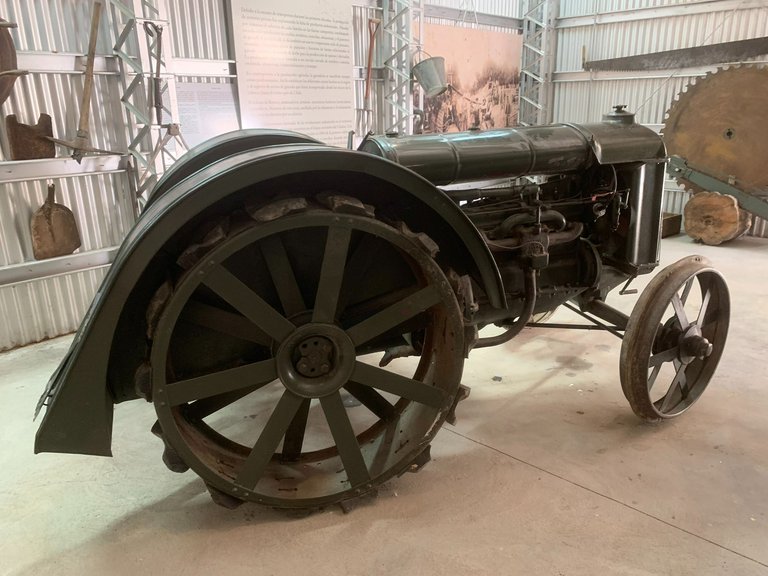
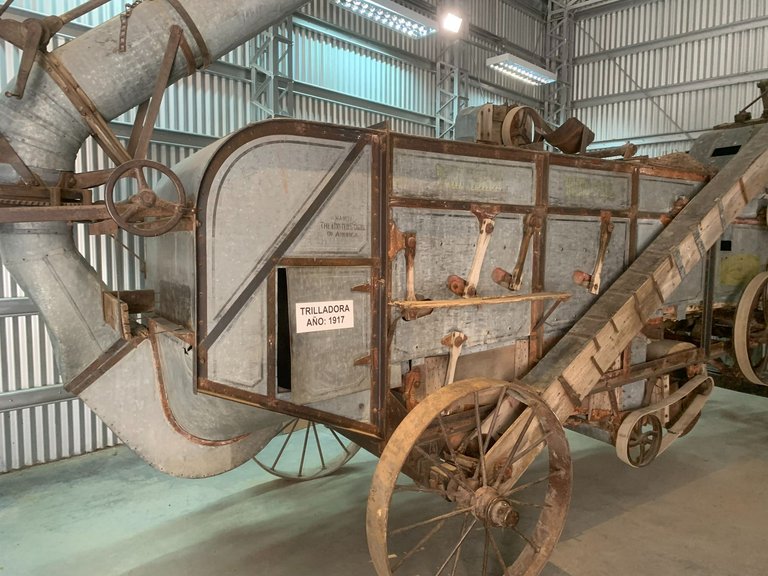
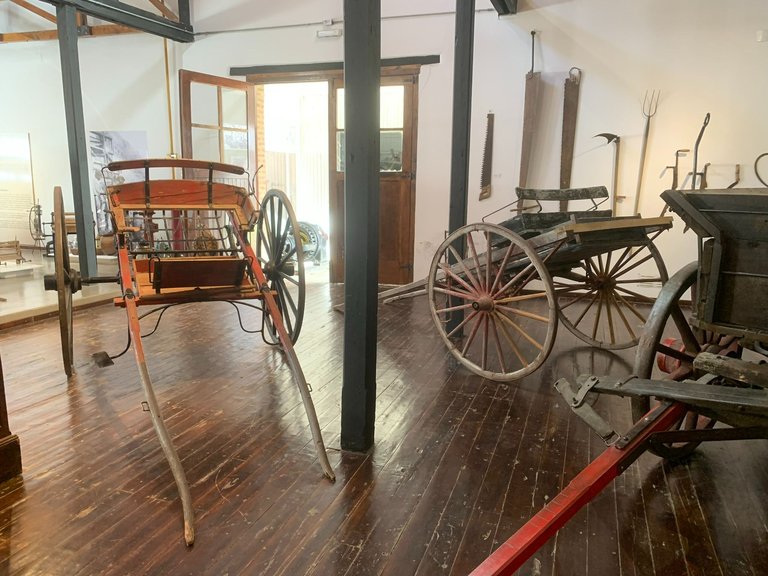








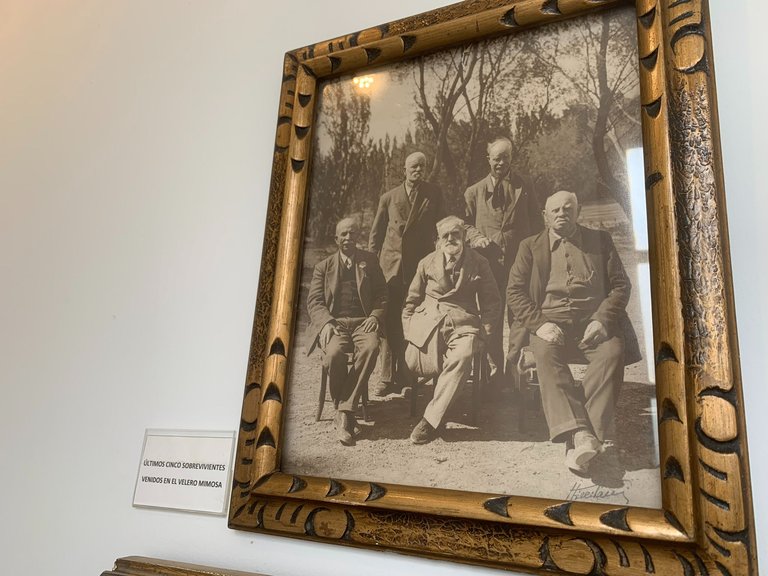
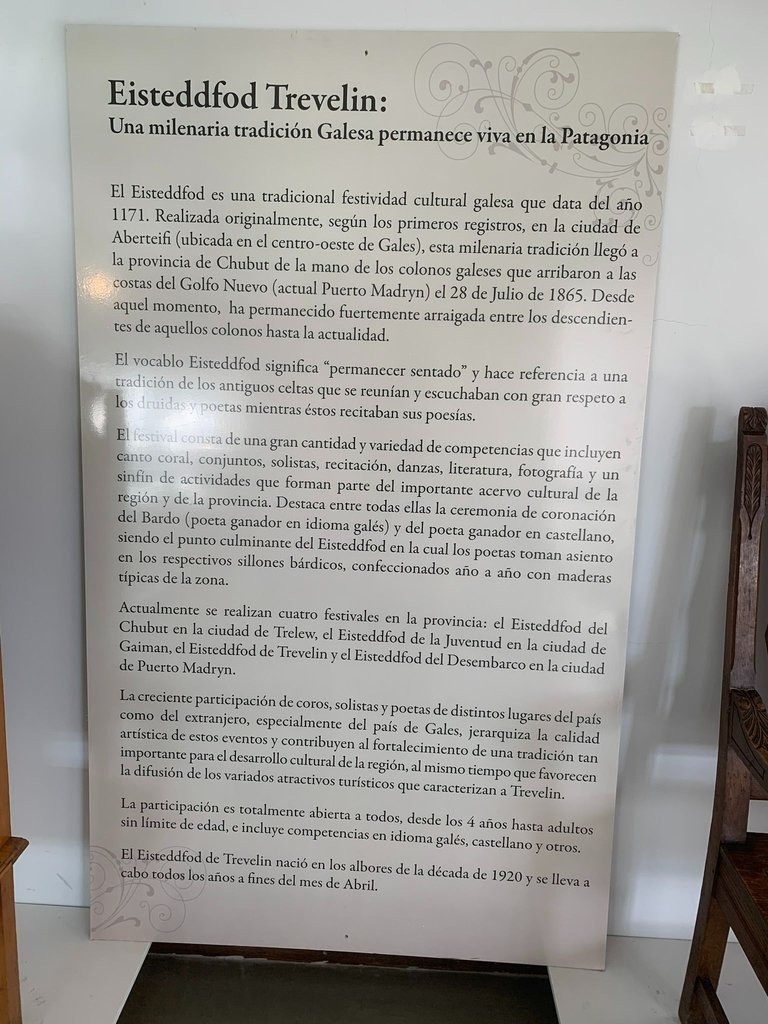


You can check out this post and your own profile on the map. Be part of the Worldmappin Community and join our Discord Channel to get in touch with other travelers, ask questions or just be updated on our latest features.
Esa frase inicial de tu publicación puede resumir la excelencia de este trabajo porque he leído el escrito de una sola vez.
Agradezco que siga mostrando trabajos como estos y, en este caso, de algo tan suyo, tan argentino que me gusta mucho.
Ojalá, en mi pueblo todo estuviera tan conservado para exponerlo en una publicación.
Gracias de todo corazón.
Escribir el presente por la historia del pasado es maravilloso.
Salud y saludos.
Muchas gracias @tonies, tu siempre tan amable con mis publicaciones. Deberías parar un poco ya que terminaré por creerme todo, jajaja.
Un cordial saludo, siento que compartimos muchas cosas pese a la distancia y la cultura diferente. Eso me hace pensar que la esencia del ser humano es más fuerte que la lúdica circunstancia del lugar de nacimiento.
Congratulations @hosgug! You have completed the following achievement on the Hive blockchain And have been rewarded with New badge(s)
Your next payout target is 27000 HP.
The unit is Hive Power equivalent because post and comment rewards can be split into HP and HBD
You can view your badges on your board and compare yourself to others in the Ranking
If you no longer want to receive notifications, reply to this comment with the word
STOPCheck out our last posts:
Absolutely stunning storytelling! The blend of personal reflection, historical detail, and cultural preservation makes this post a true gem. You transported us to Trevelin with such vivid imagery. The museum seems like a treasure trove of memory and meaning—thank you for sharing this remarkable journey through time!
Thank you for such complimentary comments.
Best regards @yugadi
It was a great trip, you managed to capture the beautiful moments in this place very well.
It was a great experience, and although I knew a lot about the place and its stories, it's motivating to be in a place that holds so much of that extraordinary era.
Best regards @riyat
Hiya, @lauramica here, just swinging by to let you know that this post made it into our Honorable Mentions in Travel Digest #2525.
Your post has been manually curated by the @worldmappin team. If you like what we're doing, please drop by to check out all the rest of today's great posts and consider supporting other authors like yourself and us so we can keep the project going!
Become part of our travel community:
Thank you @lauramica and @worldmappin
You are very welcome @hosgug! it was well deserved. ☀️
Keep up the great work 💪
Thank you @qurator
Una de las cosas que más me atrae de vuestra sociedad, es la capacidad y el hábito de cuidar el pasado...
Una nación sin memoria puede olvidar todo su patrimonio y dirigirse hacia su autodestrucción.
Ejemplos sobran!
Gran trabajo mi pana...
Abrazo
Es cierto lo que mencionas @fermionico y en lo personal es algo sobre lo que no reparo hasta que alguien me lo recuerda.
Saludos y muchas gracias mi pana.
Wow absolutely clean and very nice place to visit how are you today? I hope your doing great.🤗 Keep safe everyday
Thank you so much, @mariaantonette29, for your thoughts about this beautiful place and for your wishes for me. I'm doing my best to be well.
Love the exhibits! These often share a more powerful message than any text even just being around and starting at each piece for a couple of minutes!
That's right, @gabrielatravels, the impact of antique objects is truly powerful, especially when they're showcased in a space thoughtfully designed to highlight their beauty. Thank you for your comments.
Hola que bonito su post, sin visitar el museo aprendí mucho. Hay piezas muy curiosas y valiosas. Hay que llevar a los niños para que aprendan del pasado y construyan el futuro. Un saludo y gracias por compartir.
Muchas gracias @juliom, es realmente impactante recorrer los 4 pisos del museo, por una cuestión de espacio solo coloqué una cuarta parte de todas las fotografías que tomé.
I was amazed of how people preserved the things of ancient people things. It gives us to turn back time to imagine their life long ago. But we are so happy that we will know every details of their important belongings.
Thank you very much for your thoughts.
Best regards @rizz26
Hermosa publicación querido @hosgug !!
Siempre tan interesantes tus escritos, con un relato exquisito acompañado de muy lindas fotos que complementan perfectamente cada una de tus palabras.
Si bien tuve la suerte de conocer Trevelin, solo fue de pasada y me gustó mucho, no solo a nivel paisaje, sino por el orden y la tranquilidad de estos sitios.
Te dejo un gran abrazo querido Héctor!
Muchas gracias @pablo1601, conocí Trevelin en el año 2000, desde aquel entonces hasta ahora ha crecido muchísimo y desde hace 2 años es el sitio que eligió mi hijo menor para vivir junto a su familia y mi único nieto. Tengo la excusa perfecta para volver permanentemente.
Saludos a la familia
Se que excusas no te faltan para volver a Trevelin!
A mi queda en la lista de los pendientes. Es un sitio para recorrerlo varios días.
Abrazo grande!